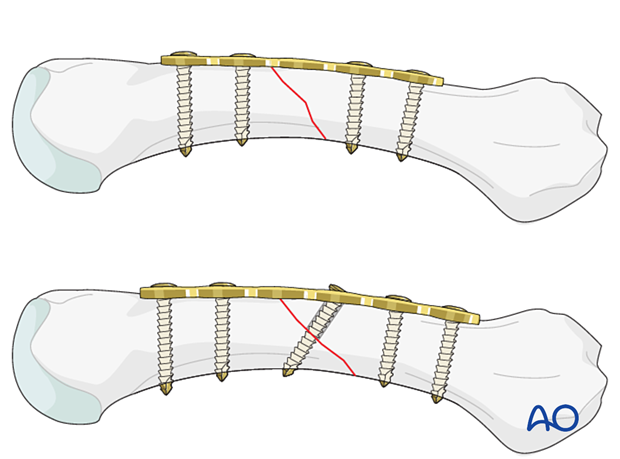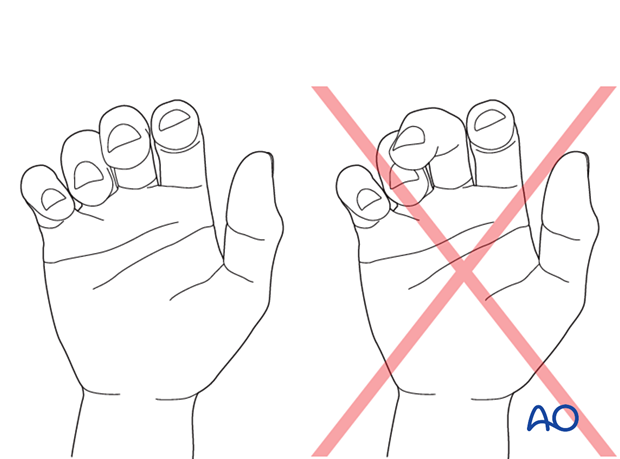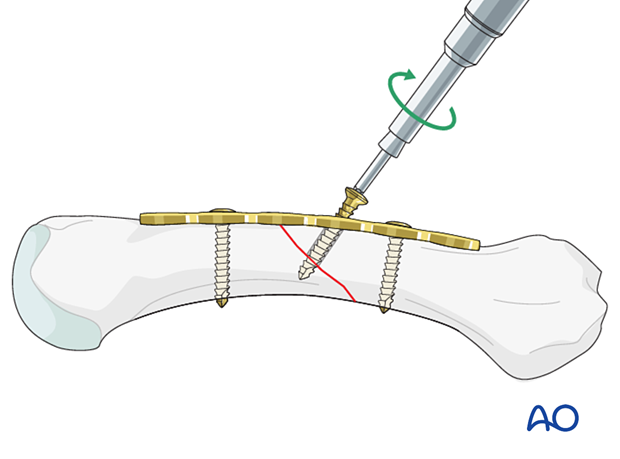Compression plating with/without lag screw
1. General considerations
Short oblique shaft fractures may be treated with open reduction and compression plate fixation.
Usually, the plate may be applied dorsally. In some fractures of the 2nd and 5th metacarpal diaphysis, the plate may be applied laterally (ie, radially and ulnarly).
This fixation follows the principles of compression plating of oblique fractures, ie, the plate should create an axilla (acute angle) with the oblique fracture line. If such an axilla cannot be created, lag-screw fixation with a neutralization plate should be considered.
Depending on the fracture morphology and surgeon’s preference, compression can be applied in one of the following modes:
- Compression with a plate
- Compression with a lag screw through a plate
Intrinsic compression can be achieved with a locking compression plate, shown in this procedure. With an anatomic plate, extrinsic compression is applied with forceps and maintained with locking head screws.

Fracture plane
Obliquity of the fracture is possible either in the plane visible in the AP view or the lateral view. Always confirm the fracture configuration with views in both planes.

Plate selection
Select a plate (1.5–2.0 mm) according to the size of the bone, fracture geometry, and surgeon’s preference.
The plate length should allow for at least two screws in each main fragment.
The plate is available as a conventional compression plate or with variable-angle (VA) locking-head screws.

2. Patient preparation
Place the patient supine with the arm on a radiolucent hand table.

3. Approaches
For this procedure, the following approaches may be used:
In the 2nd metacarpal, a radial approach may be used. In the 5th metacarpal, an ulnar approach may be used.
4. Reduction
Indirect reduction
Reduction can be achieved by axial traction and flexion of the metacarpophalangeal (MCP) joint exerted by the surgeon.
Confirm reduction with an image intensifier.
If the fracture reduction appears stable, nonoperative treatment may be considered. In this case, confirming reduction with an image intensifier is essential.

Pearl: flexing the finger

Direct reduction
Pointed reduction forceps can be used for reduction.
As most of these fractures have a flexion deformity, indirect reduction can be performed by pressure on the metacarpal head from the palmar aspect.

Preliminary fixation in unstable situations
In very unstable situations, insert a K-wire across the fracture plane for preliminary stabilization.
Be aware that the cortical bone in the metacarpals is dense and thick, so the K-wire tip gets very hot. Irrigation during insertion of the K-wire is essential to avoid thermal necrosis of the bone around the wire track.

5. Checking alignment
Identifying malrotation
At this stage, it is advisable to check the alignment and rotational correction by moving the finger through a range of motion.
Rotational alignment can only be judged with flexed metacarpophalangeal (MCP) joints. The fingertips should all point to the scaphoid.
Malrotation may manifest by an overlap of the flexed finger over its neighbor. Subtle rotational malalignments can often be judged by a tilt of the leading edge of the fingernail when the fingers are viewed end-on.
If the patient is conscious and the regional anesthesia still allows active movement, the patient can be asked to extend and flex the finger.
Any malrotation is corrected by direct manipulation and later fixed. Flexing the MCP joints while preventing overlap of the fingers will reduce rotational displacement.

Using the tenodesis effect when under anesthesia
Under general anesthesia, the tenodesis effect is used, with the surgeon fully flexing the wrist to produce extension of the fingers and fully extending the wrist to cause flexion of the fingers.

Alternatively, the surgeon can exert pressure against the muscle bellies of the proximal forearm to cause passive flexion of the fingers.

6. Plate fixation
Plate preparation
If the plate is perfectly adapted to the convexity of the dorsal metacarpal surface, tightening the screws may result in a gap in the opposite cortex.
The solution is the same as all diaphyseal long bone transverse and oblique fractures. The plate is contoured, so that it is overbent relative to the bone surface. When screws are tightened, compression is then applied across the whole fracture plane including the opposite cortex.

Plate application
Select a plate with at least 5 holes and center it over the fracture.
Ensure that the plate is centered on the long axis of the diaphysis.


Apply the compression plate according to standard techniques.
Insert the first screw to create an axilla (acute angle) between the plate and one of the fragments. The apex of the second fragment can then be reduced into the axilla.

Checking for rotational alignment
After inserting the second screw, check the rotational alignment again.

Completing fixation
Insert the remaining screws in neutral mode to provide improved resistance to rotational forces applied to the plate.
Cover the plate with periosteum to avoid adhesion between the tendon and the implant leading to limited finger movement.

7. Compression with a lag screw through the plate
A lag screw may, in some cases, be inserted across the fracture plane to augment stability.

Insert the remaining screws in neutral mode to provide improved resistance to rotational forces applied to the plate.

8. Final assessment
Confirm correct rotational alignment by clinical examination.
Image intensification may be used to confirm anatomical reduction and correct placement of implants in two views.
9. Aftercare
Postoperative phases
The aftercare can be divided into four phases of healing:
- Inflammatory phase (week 1–3)
- Early repair phase (week 4–6)
- Late repair and early tissue remodeling phase (week 7–12)
- Remodeling and reintegration phase (week 13 onwards)
Full details on each phase can be found here.
Postoperative treatment
If there is swelling, the hand is supported with a dorsal splint for a week. This would allow for finger movement and help with pain and edema control. The arm should be actively elevated to help reduce the swelling.
The hand should be splinted in an intrinsic plus (Edinburgh) position:
- Neutral wrist position or up to 15° extension
- Metacarpophalangeal (MCP) joint in 90° flexion
- Proximal interphalangeal (PIP) joint in extension

The reason for splinting the MCP joint in flexion is to maintain its collateral ligament at maximal length, avoiding scar contraction.
PIP joint extension in this position also maintains the length of the volar plate.

After subsided swelling, protect the digit with buddy strapping to a neighboring finger to neutralize lateral forces on the finger.

Functional exercises
To prevent joint stiffness, the patient should be instructed to begin active motion (flexion and extension) immediately after surgery.

Follow-up
See the patient after 5 and 10 days of surgery.
Implant removal
The implants may need to be removed in cases of soft-tissue irritation.
In case of joint stiffness or tendon adhesion restricting finger movement, arthrolysis or tenolysis may become necessary. In these circumstances, the implants can be removed at the same time.













